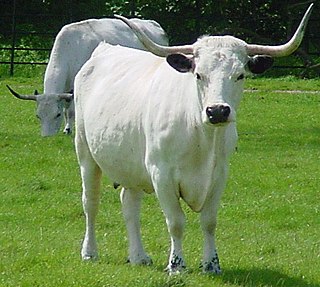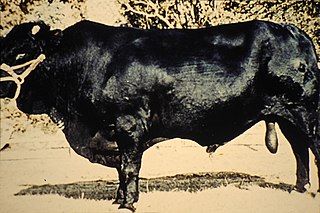
The Highland is a Scottish breed of rustic cattle. It originated in the Scottish Highlands and the Western Islands of Scotland and has long horns and a long shaggy coat. It is a hardy breed, able to withstand the intemperate conditions in the region. The first herd-book dates from 1885; two types – a smaller island type, usually black, and a larger mainland type, usually dun – were registered as a single breed. It is reared primarily for beef, and has been exported to several other countries.

The Hereford is a British breed of beef cattle originally from Herefordshire in the West Midlands of England. It was the result of selective breeding from the mid-eighteenth century by a few families in Herefordshire, beginning some decades before the noted work of Robert Bakewell.

The Longhorn or British Longhorn is a British breed of beef cattle characterised by long curving horns. It originated in northern England, in the counties of Lancashire, Westmorland and Yorkshire, and later spread to the English Midlands and to Ireland. It was originally a slow heavy draught animal; cows gave a little milk, although high in fat. In the eighteenth century Robert Bakewell applied his methods of selective breeding to these cattle, which for a short time became the predominant British breed. Both the numbers and the quality of the breed declined throughout the nineteenth century and for much of the twentieth. A breed society was formed in 1878, and a herd-book published in that year.

The Galloway is a Scottish breed of beef cattle, named after the Galloway region of Scotland, where it originated during the seventeenth century.

The Guernsey is a breed of dairy cattle from the island of Guernsey in the Channel Islands. It is fawn or red and white in colour, and is hardy and docile. Its milk is rich in flavour, high in fat and protein, and has a golden-yellow tinge due to its high β-carotene content. The Guernsey is one of three Channel Island cattle breeds; the other two are the Alderney, which is now extinct, and the Jersey.

The Dairy Shorthorn is a British breed of dairy cattle. It derives from the Shorthorn cattle of Teesside, in the North Riding of Yorkshire and in Northumbria in north-eastern England. The Shorthorn was for this reason at first known as the Durham or Teeswater.

The Dexter is an Irish breed of small cattle. It originated in the eighteenth century in County Kerry, in south-western Ireland, and appears to be named after a man named Dexter, who was factor of the estates of Lord Hawarden on Valentia Island. Until the second half of the nineteenth century it was considered a type within the Kerry breed.

The Murray Grey is an Australian breed of polled beef cattle. It originated between 1905 and 1917 in the upper Murray River valley, on the border between New South Wales and Victoria. It is similar in appearance to the Aberdeen Angus, from which it largely derives, but is grey, silver or dun in colour.

The Afrikaner or Africander is an African breed of taurine-indicine cattle in the Sanga group of African cattle. It is derived from the cattle of the Khoikhoi (Hottentot) people which were already present in the area of modern South Africa when the Dutch East India Company established the Cape Colony in 1652.

The Belted Galloway is a traditional Scottish breed of beef cattle. It derives from the Galloway cattle of the Galloway region of south-western Scotland, and was established as a separate breed in 1921. It is adapted to living on the poor upland pastures and windswept moorlands of the region. The exact origin of the breed is unclear, although the white belt for which they are named, and which distinguishes the breed from black Galloway cattle, is often surmised to be the result of cross-breeding with the similarly-coloured Dutch Lakenvelder breed.

The South Devon is a British breed of large beef cattle. It originated in the counties of Devon and Cornwall in south-west England, and is mentioned from the eighteenth century. It was a dual-purpose breed, kept both for its milk and for beef. Since 1972 selection has been for beef only.

The White Park is a modern British breed of cattle. It was established in 1973 to include several herds or populations of colour-pointed white cattle – white-coated, with points of either red or black on the ears and feet. Such cattle have a long history in the British Isles, and the origins of some herds go back to the Middle Ages.

The Old Gloucester or Gloucester is a traditional British breed of cattle originating in Gloucestershire and surrounding areas in the West Country of England. It was originally a triple-purpose breed, reared for milk, for beef and for draught use; it is now a dual-purpose animal. It is an endangered breed, and its conservation status is listed as "priority" by the Rare Breeds Survival Trust.

The Dorset Horn is an endangered British breed of domestic sheep. It is documented from the seventeenth century, and is highly prolific, sometimes producing two lambing seasons per year. Among British sheep, it is the only breed capable of breeding throughout the winter.

Murnau-Werdenfels Cattle are an old, robust dairy breed from Upper Bavaria, the southernmost part of Germany.

The Romagnola is a breed of cattle from the Emilia-Romagna region of Northern Italy. It belongs to the Podolic group of grey cattle. Romagnola cattle were used principally as draught beasts in the past; since the mechanisation of agriculture in the middle of the twentieth century they have been bred primarily for beef production.

The Parthenaise is a French cattle breed. It is named for the town of Parthenay in the département of Deux-Sèvres, in the Nouvelle-Aquitaine region of western France. It was formerly a triple-purpose breed, raised for milk, meat and draught work, but is now raised mainly for beef.

The Lincoln Red is a British breed of red-coated beef cattle. It originates in, and is named for, the county of Lincolnshire in the eastern Midlands of England. It was selectively bred in the late eighteenth and early nineteenth centuries by crossing large local draught cattle of the region with Teeswater Shorthorns of medium size. It was at first known as the Lincolnshire Red Shorthorn, and was a dual-purpose breed, reared both for milk and for beef. The polling gene was introduced in the early twentieth century, and the cattle are now usually polled; the word 'shorthorn' was dropped from the breed name in 1960. In the twenty-first century it is reared for beef.

The Corse or Corsicana is a French breed of cattle indigenous to the island of Corsica.

The Drakensberger is a South African breed of cattle. It is a dual-purpose breed, reared both for milk and for meat. Its origins go back to the early nineteenth century, to the time of the Great Trek or earlier, when imported European stock from Holland was cross-bred with black cattle of Sanga type obtained from nomadic pastoralist Khoikhoi peoples. It is one of several successful African composite breeds of Sanga and European stock. In the early days it was selected for adaptation to the sourveld biome of South Africa, and for black colour; it was kept principally along the Drakensberg escarpment, which gave rise to its modern name. It was established as a breed with the formation of the Drakensberger Cattle Breeders' Society in 1947.





















